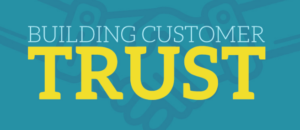Companies are in a bit of a crisis in the modern era. Even though consumer-brand trust is as important as ever, the sad fact is, people, don’t trust brands. Therefore you need to build customer trust.

They see corporations as faceless profiteers, a sentiment brought on by tales of corruption in big business, the 2008 financial crisis, and the constant bombardment of advertising over the past several decades.
Your audience wants to see you, hear you and understand you. They want you to inspire them to connect and engage with you. They want you to help them achieve their goals and objectives. They want relevant content and conversation that makes them think. They want inspired to do different, do better and be better.
Humanizing your brand is a requirement, not an option if you want to survive in business today. Yes, you can put brand humanization on hold. However, every day you lose is a day you could be building relationships, nurturing friendships, establishing and earning the respect of powerful brand evangelists who will shout from a mountain top how wonderful you and your brand are.
Don’t wait. The time is now. You don’t have to be a rocket scientist or brain surgeon to do these things. Start now and start somewhere. Perfection is the enemy of the good. Embrace imperfect perfection.
Since people trust other people more than they do brands, all you have to do is make your brand seem a little bit more like a person—you have to humanize your brand.
Here are 9 practical steps to help you do so:
Focus on relationships
You must get out of the old school thinking of only email blasts, traditional advertising. Think about the conversations, the content and the way you can build relationships with real human beings. If you think like a corporate engine or cog in the wheel, you are going to have a hard time connecting as a human being.
Relationships are the life raft of the never ending social network technology changes. If you focus on the relationships, your audience will follow you wherever you go, despite how the social landscape changes. This is because they are not connecting with you as a Twitter handle or brand name, but instead as a human being or group of human beings.
In his book Permission Marketing, Seth Godin pioneered the idea of content marketing. Create something of value that will motivate people to provide you with an email address. The problem is, we’re competing for attention with so much noise, so earning that conversion has become increasingly difficult. There are over 80 billion business emails sent every week and over 200 million hours spent on YouTube. Consumers have access to a lot of content and are weary of another brand sending more emails into their already cluttered lives.
Create an interactive avatar
Your brand needs a human voice, and a personality, but it’s hard to assign those qualities to a logo or a corporate name. Instead, try assigning them to an actual personal framework. Come up with a fictional character who represents your brand, and flesh out all the details.
Who is this person? What’s their name? How do they dress? What’s their favorite food? What are their likes and dislikes? Are they excitable or calm? Formal or casual? These questions will help you imagine a real personality to serve as your brand’s avatar, and from there it’s easy to slip into that mentality. This is the best way to have to almost literally humanize your brand.

Build customer trust … engage in conversations
Don’t just post ads to your users; engage them in conversation. Ask them what they like and what they want to see. If they tell you they like one of your posts, thank them for their readership. If you see your audience members commenting on an external thread, jump into the discussion.
This shows that you’re paying attention and that you care about more than just one side of the conversation. The more you engage with your users, the more likely they’ll be to see you as a trustworthy, personal entity. Again, this requires more work; it’s easier to sit back and throw out an extended monolog. But when you engage with individuals, you’ll instantly cement those individuals’ loyalties, and you’ll look good to everyone else looking on.
Communicate with your customers
Delete the corporate mumbo jumbo speak. Social media is not a billboard for your 1995 corporate collateral. Speak to a tone, words and rhythm your customers, partners and social community can understand. Use language that inspires them and connects them to you and your brand.
Show material from behind the scenes
This is one of the best ways to become a human brand. Share the moments that you are human. If you have a company party or picnic, take some photos and share them. If your team goes on a team building mission or hike, let your audience know ahead of time they are going. Ask them who they think will win the contest.
Share the fun and serious moments your team has offline working to help your clients meet their goals. If you have a team meeting, share a couple of photos of the team brainstorming at the whiteboard or enjoying themselves with a bag of candy or popcorn. You’ll be amazed at how these simple little shares of your personal side will help build a relationship with the people in your community. Try it, it works!
Show a sense of humor
Humor has a primal way of connecting us. When we laugh together, we tear down walls and bond with each other—it’s why we’re more likely to laugh when we’re surrounded by people we care about than we are when we’re by ourselves. When you make your users laugh, you show them that you don’t take yourself too seriously.
You show them that you enjoy humor just like the rest of us and that you aren’t afraid to set aside the formal professionalism of your brand for just a moment to experience a human moment.
Obviously, the type and appropriateness of humor you use will be dependent on your brand, but self-deprecating humor and tongue-in-cheek references both work especially well for audiences. You don’t have to be a consistent comedian, but you have to throw out enough references and asides to keep your audience feeling good about you.
Show your personality
Knowing who you are is obviously key to having a brand personality. If you don’t know what your brand personality is then you better figure it out. Who are you? What are you? Are you serious? Are you funny? Are you a combination of both? What is the tone of your conversations? The tone of your educational material?
Social media is going to open everything up for everyone to see. If you have one personality online and another when a customer calls your support center, it is going to become quite apparent. Nail this in the early stages, and it will become an asset to you forever.
Be visible and responsive

Regardless if you are communicating with your customers, partners, and audience online or offline simply be available. Don’t setup the latest social network profile unless you plan actually to show up. Show up more than once a week or once a day.
Don’t show up to just brag about your latest reward won, promotion or blog post. Instead, show up with a goal to inspire and connect with your audience with an underlying goal of helping them achieve their objectives. Be proactive and responsive to the interest of your audience and fans at the heart of all.
It’s one thing to provide the opportunity for your customers and community to give their feedback and voice their desires. It’s entirely another to show them you’ve listened by responding through action. When you truly listen to someone, you gain their trust, and more importantly, their respect.
Show emotions
Emotional brands are the brands that are building real relationships in the social ecosystem. Make me laugh. Make me cry or make me mad. Do something that makes me think different, be different. Inspire me to do more, be more and leverage you, your team or your products and services to do such. The more you can connect with your audience, the better you will be at understanding what emotional chords will work best with them.
Being authentic and genuine isn’t something that companies can fake. Consumers are smart, and they expect a lot from the brands they choose to support. More than a great product or service, it’s the passion and cause at the core of the company that builds this much deeper emotional connection between the brand and the customer. All of which can be fostered through personal, meaningful, and relevant content.
The bottom line
Did this post motivate you to better humanize your business? Does your business truly connect with people? Or are you guilty of corporate speak? If you have already been thru this process and have made strides toward becoming a social business with humanization at the core, what tips can you provide for others?
The good news is that all of this stuff is pretty simple. We’re all human beings. We all work with other human beings. We all know that we need to treat our customers how we would like to be treated.
The bad news is that simple is not the same thing as easy. Humanizing your brand, building trust, fostering an authentic and lasting connection with your customers is hard work. It doesn’t necessarily scale. And unless you can tap into some genuine, authentic passion of your own, the connection is going to be a whole lot harder to ignite.

Need some help in building better customer insights from your customer engagement? Creative ideas to help grow your customer base?
Call today for a FREE consultation or a FREE quote. Learn about some options to scope your job of growing customer insights and pay for results.
Call Mike at 607-725-8240.
All you get is what you bring to the fight. And that fight gets better every day you learn and apply new insights that you have learned.
When things are not what you want them to be, what’s most important is your next step. Call today.
Test. Learn. Improve. Repeat.
Are you devoting enough energy to improving your continuous learning for yourself and your team?
Digital Spark Marketing will stretch your thinking and your ability to adapt to change. We also provide some fun and inspiration along the way. Call us for a free quote today. You will be amazed how reasonable we will be.
Check out these additional articles on customer insights from our library:
The Story of How JetBlue Turns Customers into Advocates
Small Business Customer Insights 101
Remarkable Marketing Using These 17 Customer Insight Techniques
A How-to Guide for Small Business Social Media Marketing
Mike Schoultz is a digital marketing and customer service expert. With 48 years of business experience, he consults on and writes about topics to help improve the performance of small business. Find him on G+, Facebook, Twitter, Digital Spark Marketing, and LinkedIn.